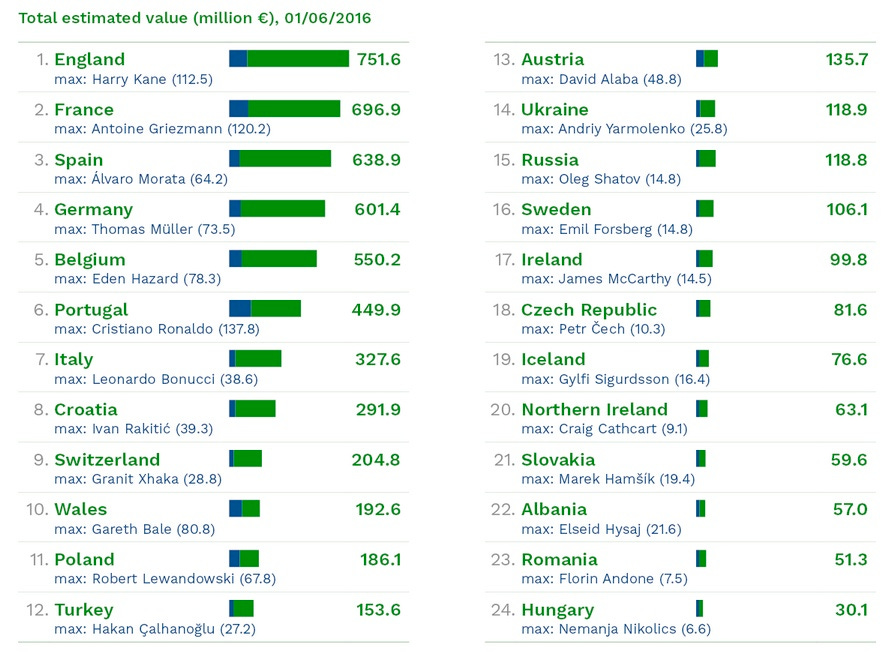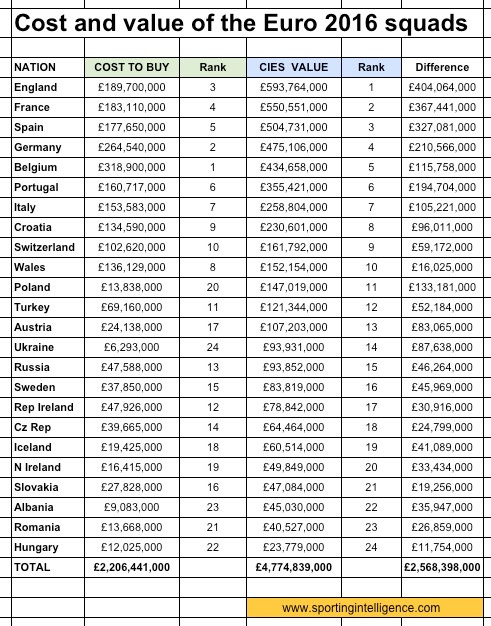Euro 2016 squads: cost £2.2bn but worth more than double
By Nick Harris
10 June 2016
Two interesting and credible studies published this week have attempted to quantify the cost (and separately, the value) of the 24 squads that will contest Euro 2016, which begins this evening in Paris when hosts France face Romania at the Stade de France.
The first was conducted by Profit Accumulator and can be read about in more detail here. The premise was straightforward but insightful - to add up the last transfer fee paid for each of the 552 players at the event and calculate the cost of accumulating each squad.
As we'll see in a moment, Belgium came out as the most expensively assembled squad, followed by Germany, England, France and Spain, with Ukraine at the bottom and Albania, Hungary and Romania also 'cheap'.
The second study was done by the CIES Observatory, an organisation that regular readers of this site will know. The Observatory used their player valuation method to calculate the current market values of the 24 squads. Their study is here. England came out on top this time, ahead of France, Spain, Germany and Belgium, with Hungary, Romania and Albania at the bottom.
Both these studies are objectively sound, and debate-provoking. Here we'll examine what they might tell us about the make-up of the 24 squads.
The cost of the 24 squads
The headline finding in the study about squad costs (not values) is that Belgium's 23 players cost their current employers £318.9m combined, or an average of £13.9m each. This puts them well ahead of the second most pricey squad, Germany (£264.5m), England (£189.7m), France (£183.1m) and Spain (£177.65m).
No fewer than a dozen Belgian players last transferred at a cost of £10m or more, headed by Kevin de Bruyne of Man City (£55m), Christian Benteke of Liverpool (£32.5m) and Eden Hazard of Chelsea (£32m). The others are Zenit's Axel Witsel (£30m), Everton's Romelu Lukaku (£28m), Manchester United's Marouane Fellaini (£27.5m), Tottenham's Mousa Dembele (£15m) and Toby Alderweireld (£12m), Barcelona's Thomas Vermaelen (£15m), Roma's Radja Nainggolan (£11.25m), Atletico's Yannick Ferreira Carrasco (£13m) and Liverpool's Divock Origi (£10m).
Before we examine the detail of the other squads, here are the results in a detailed summary.
Click to enlarge if necessary. Article continues below

.
This detail tells us all sorts of things, including that Belgium players were zeitgeist buys not long ago and have been transferring for large sums, primarily to English clubs, some of them paying over the odds, arguably. It also confirms what many of us would assume anyway: the 'big' nations have the best and most valuable players while the reverse is true for the smaller countries.
What the bare graphic doesn't show is the 552 individual stories, and how some players now perceived to be extremely valuable actually cost their clubs nothing, or nearly nothing. Premier League title winner Jamie Vardy famously cost Leicester just £1m, for example, while Harry Kane was 'home grown' by Tottenham as were (free players) Jack Wilshere of Arsenal, Everton's Ross Barkley and Manchester United's Marcus Rashford. Each of them could now command a fee of tens of millions of pounds in the market.
Sportingintelligence has had access to the full data set and striking stories about particular players include:
Paul Pogba was beyond a shadow of a doubt the best player Alex Ferguson ever let slip from his grasp at Manchester United, with United having to settle for just £800,000 compensation after failing to convince him in 2012 his future was at Old Trafford. He is now one of the best talents in the game, worth approaching £100m in some estimations. The French numbers also remind us again of Lyon's capacity to rear good young talent, home-grown (and free) Samuel Umtiti now coveted far and wide.
Just one brilliant player can make a difference to a nation. Wales are in eighth place on the 24-nation list (costing £136m), with Gareth Bale of Real Madrid (£86m) accounting for 63 per cent of the total. He has also scored almost the same percentage of all Wales goals scored by the current squad. Wales are as high as eighth because Bale is Welsh, just as Portugal are as high as they are because Cristiano Ronaldo is Portuguese.
Germany's youth system has produced some brilliant talent for clubs who paid no fees, like Thomas Muller at Bayern, and Benedikt Höwedes and Leroy Sané (both Schalke), while the lure of Bayern is so mighty that it's easy for them to tempt big names to switch from Germany's next best club Dortmund, Poland's Robert Lewandowski among them, in his case for nothing.
Ukraine's entire squad cost less than one twelfth of Gareth Bale alone. That is because they're a blend of old-timer journeymen, albeit seasoned, and home-reared players still at their development clubs into their 20s. The majority of the 14 players under the age of 27 in the Ukraine squad came through the youth systems at Shakhtar Donetsk, Dynamo Kyiv or Zorya Luhansk.
Spain's squad would have cost more if Barcelona in particular hadn't developed players still with them worth tens of millions while Austria have a 'free' gem in Bayern's David Alaba. France have diamonds aside from Pogba in players with recently soaring values or with values about to soar, notably N'Golo Kante and Kingsley Coman.
. All that said, the cost of the 24 squads as revealed by this study largely tells us that the big talents remain concentrated in the big nations. And also that any players working in England are likely to have price tags elevated above what clubs outside the Premier League would be likely to pay for them. The 552 players at the tournament were collectively last transferred for just over £2.2bn, giving the average player a value of £3.99m. The 133 players from English clubs (97 in the Premier League) are collectively most valuable at £953m. .
The value of the 24 squads
The Football Observatory's method of squad evaluation uses their tried and tested formula that attempts to calculate a 'real world' market price for any given player at any given point in time. To find out more about this in detail, look here; it's worth the time. For those who don't have time or can't be bothered, the formula takes into account a player's age and position and performance levels for club and country (factoring in the quality of club and country) as well as the individual circumstances relating to the player's contract and deal expiry date. It is, of course, imperfect. Any such system is imperfect. But quite probably it is the least imperfect valuation method available. The calculations are informed by what has happened in thousands of real deals over years. They have in the past had a close relationship with the amounts of money subsequently paid for players. In other words, the Observatory numbers have been right or close to right a lot of the time. And when they've been wrong, often they have undervalued a player, not over-valued him. So that's the methodology. Here is what the Observatory found to be the values of the 24 squads. NB: currency is euros. Click to enlarge. Article continues below.

. So what do these two studies, both credible in their own ways, show us? As our third graphic shows, we've converted the euros of the Observatory study into like-for-like pounds and summarised both pieces of work. The conclusions: 1: The 24 squads cost their employers £2.2bn but those assets are now collectively worth more than double, or £4.8bn. That's indicative of a booming market in elite players, albeit one fuelled primarily by TV riches in England and the massive cash piles of the few mega clubs elsewhere, namely Real Madrid, Barcelona, Bayern Munich and PSG, plus, to a lesser extent, Juventus and a few clubs mainly in Germany and Spain being made rich by money from selling to English clubs. 2: The top five nations by cost are also the same top five nations by value, in a slightly different order. England are 'worth' a whopping £404m more than they 'cost'. France are not far off that. Spain and Germany are also worth hundreds of millions more than their clubs paid and the Belgians are not far off what they cost. 3: The rest of the nations are, within a few places, ranked the same in value as they were in cost, with the exceptions of Poland (worth a lot more than they cost, with Lewandowski a big part of that) and Ukraine (where those free home-growns now have a value). That's a simplified summary, of course. Who's going to win? If money reflects talent and talent delivers then England, France, Spain, Germany or Belgium. Only three of those nations both fall into the top four of both studies, so let's eliminate the others and say England, France or Germany.

.


